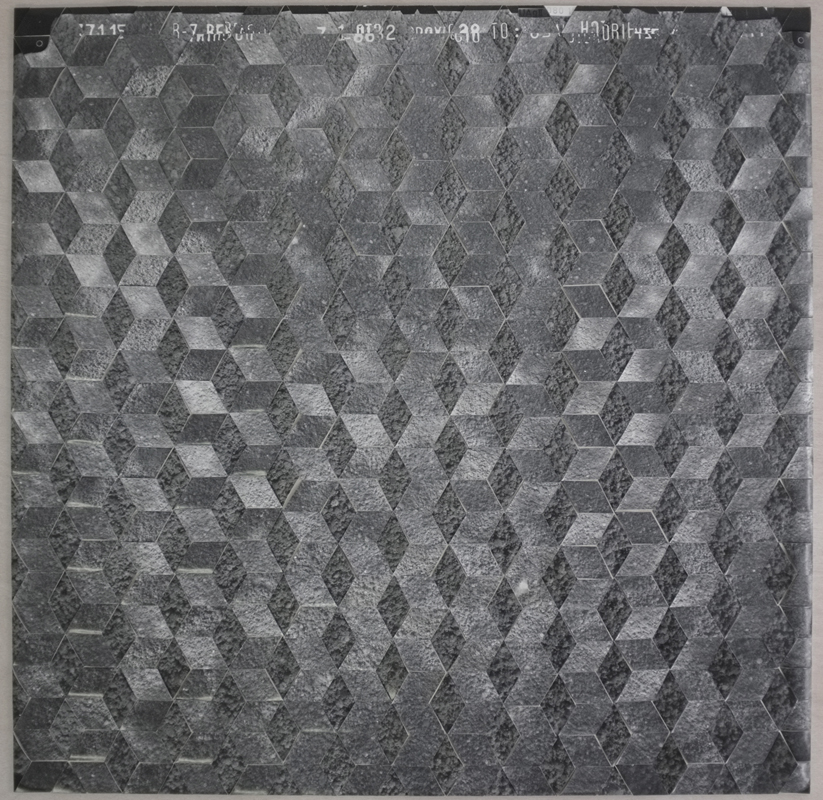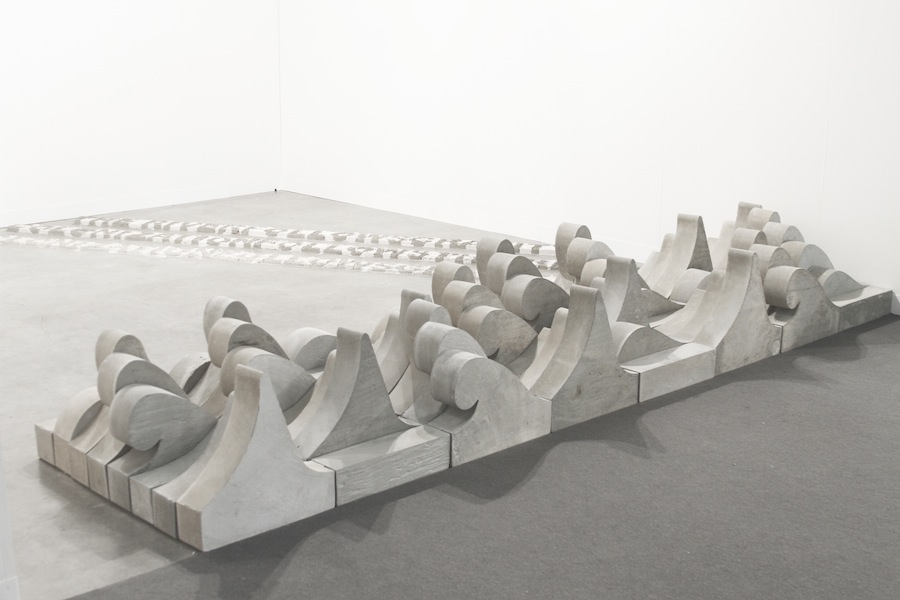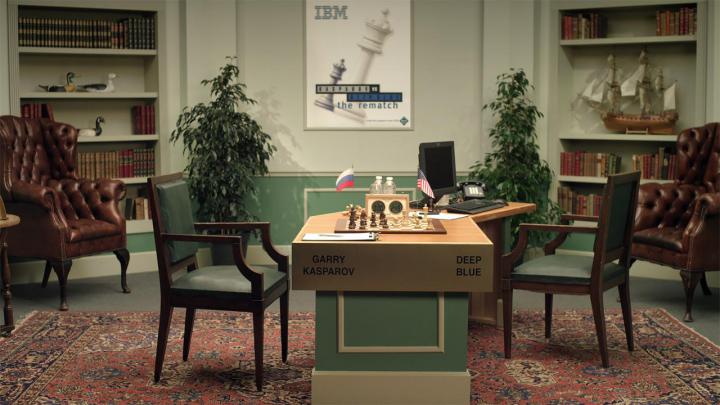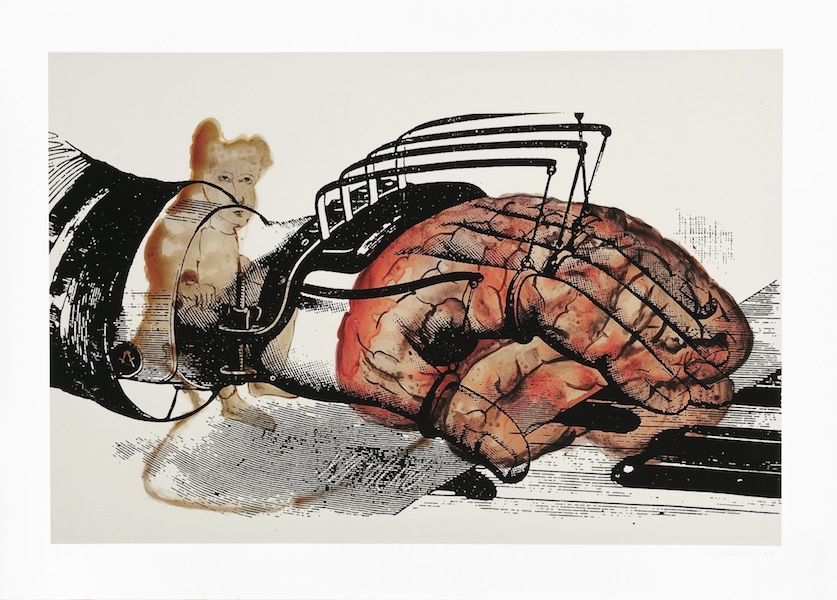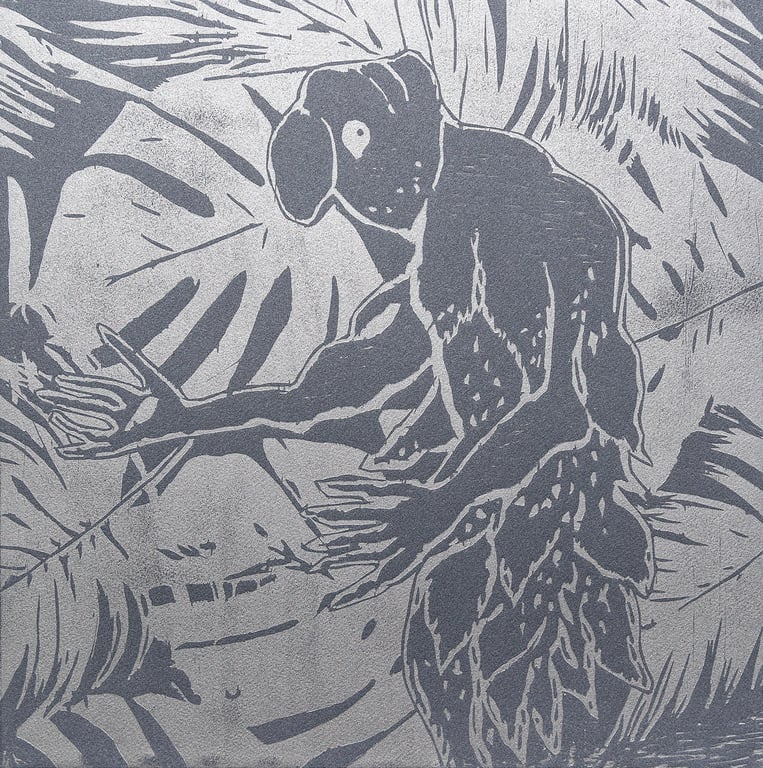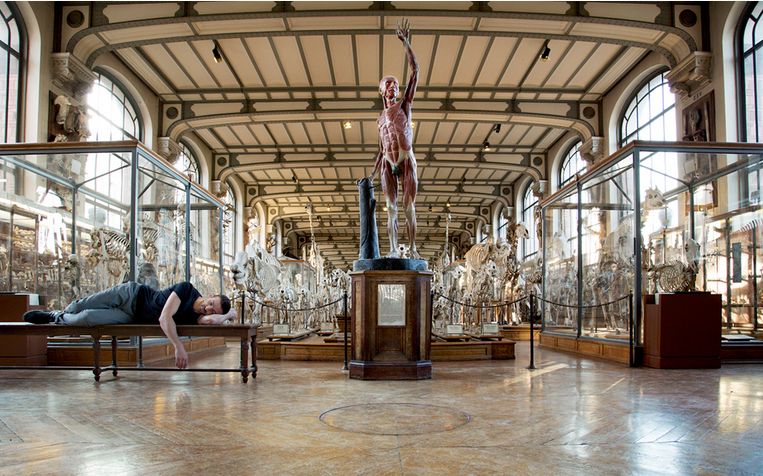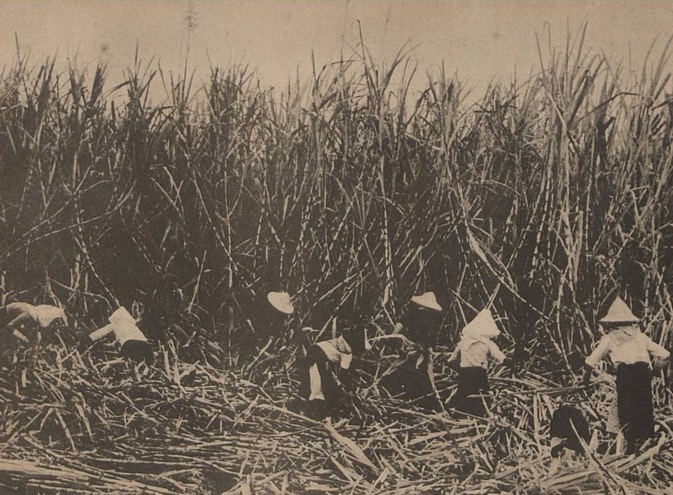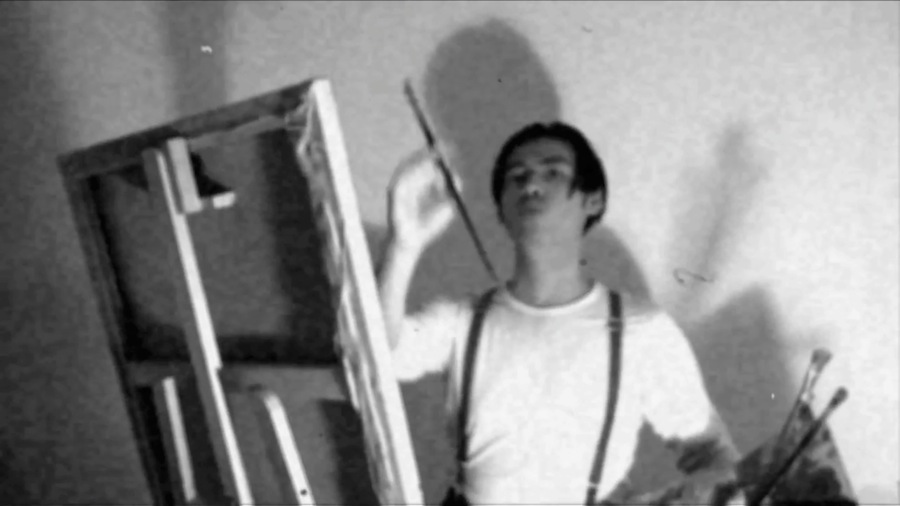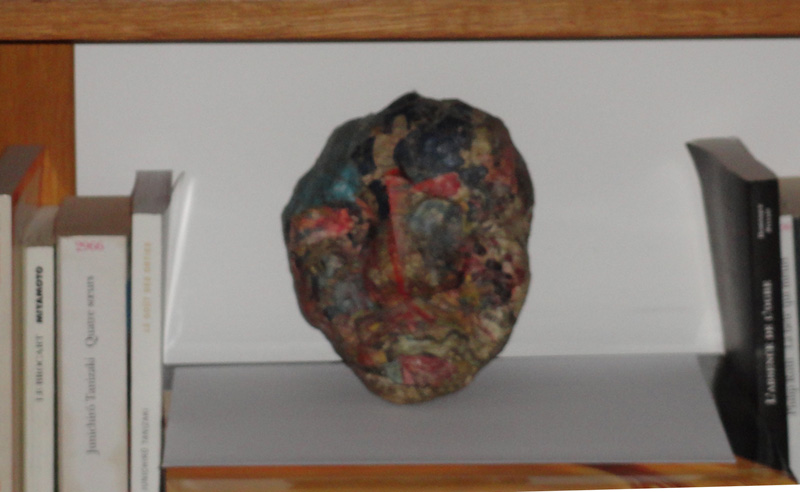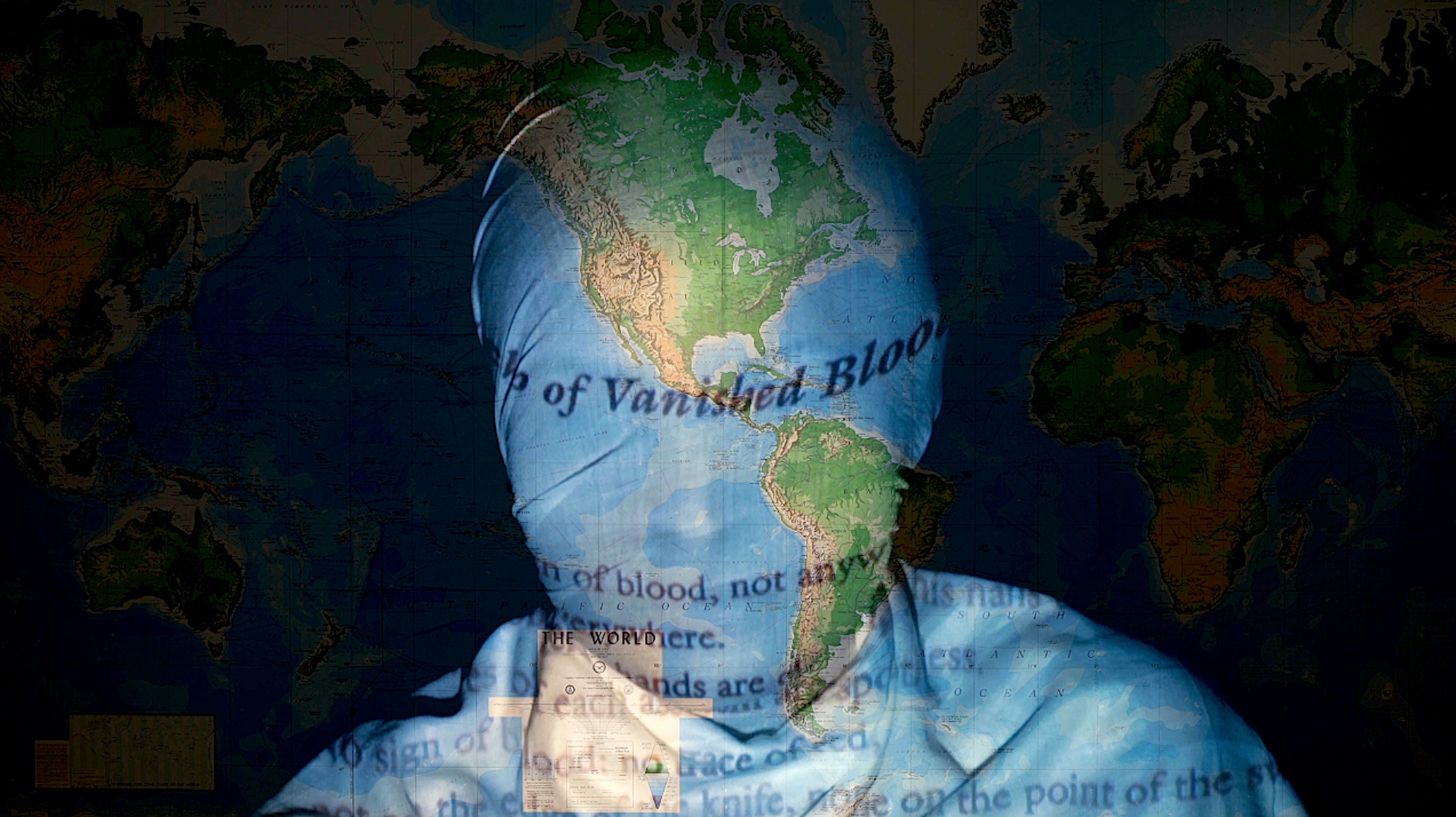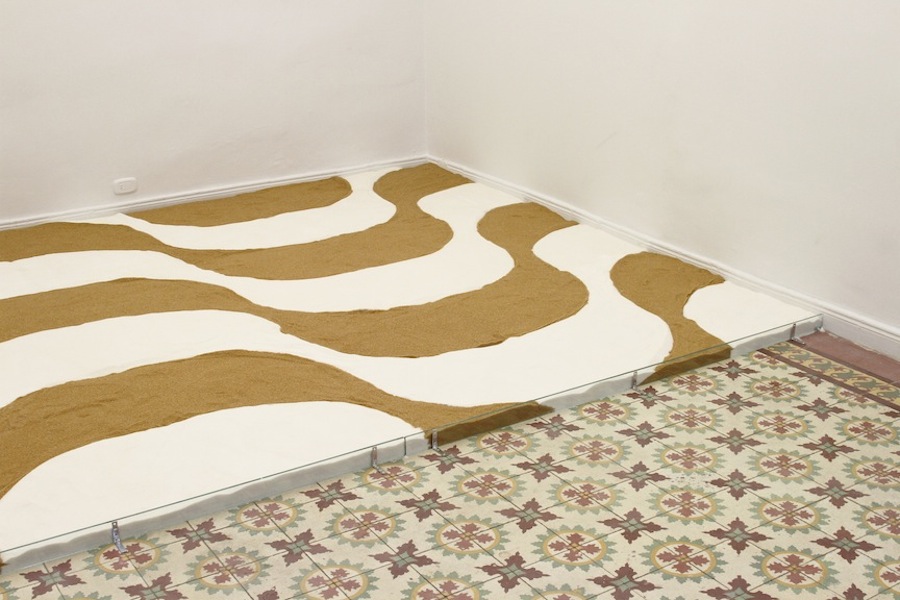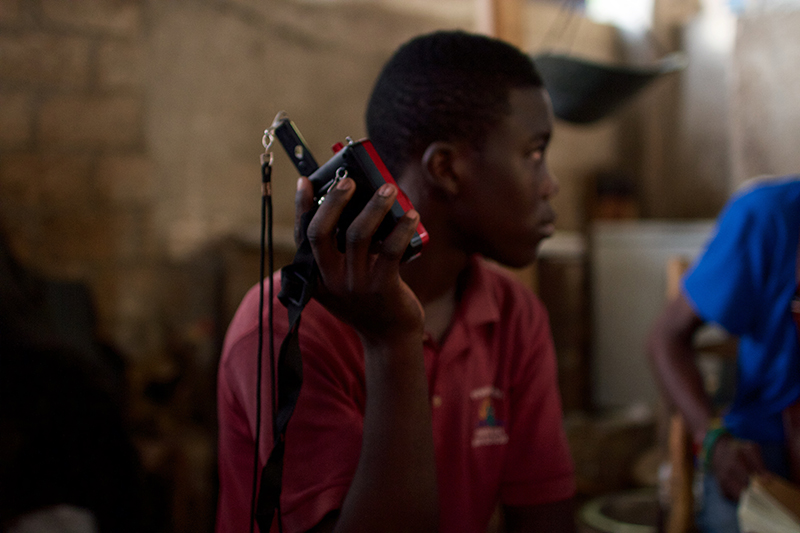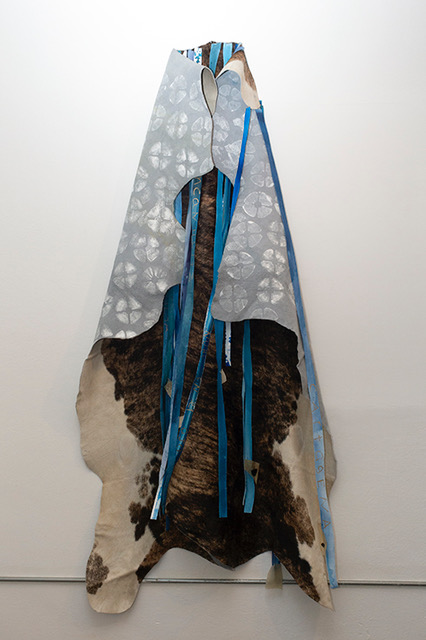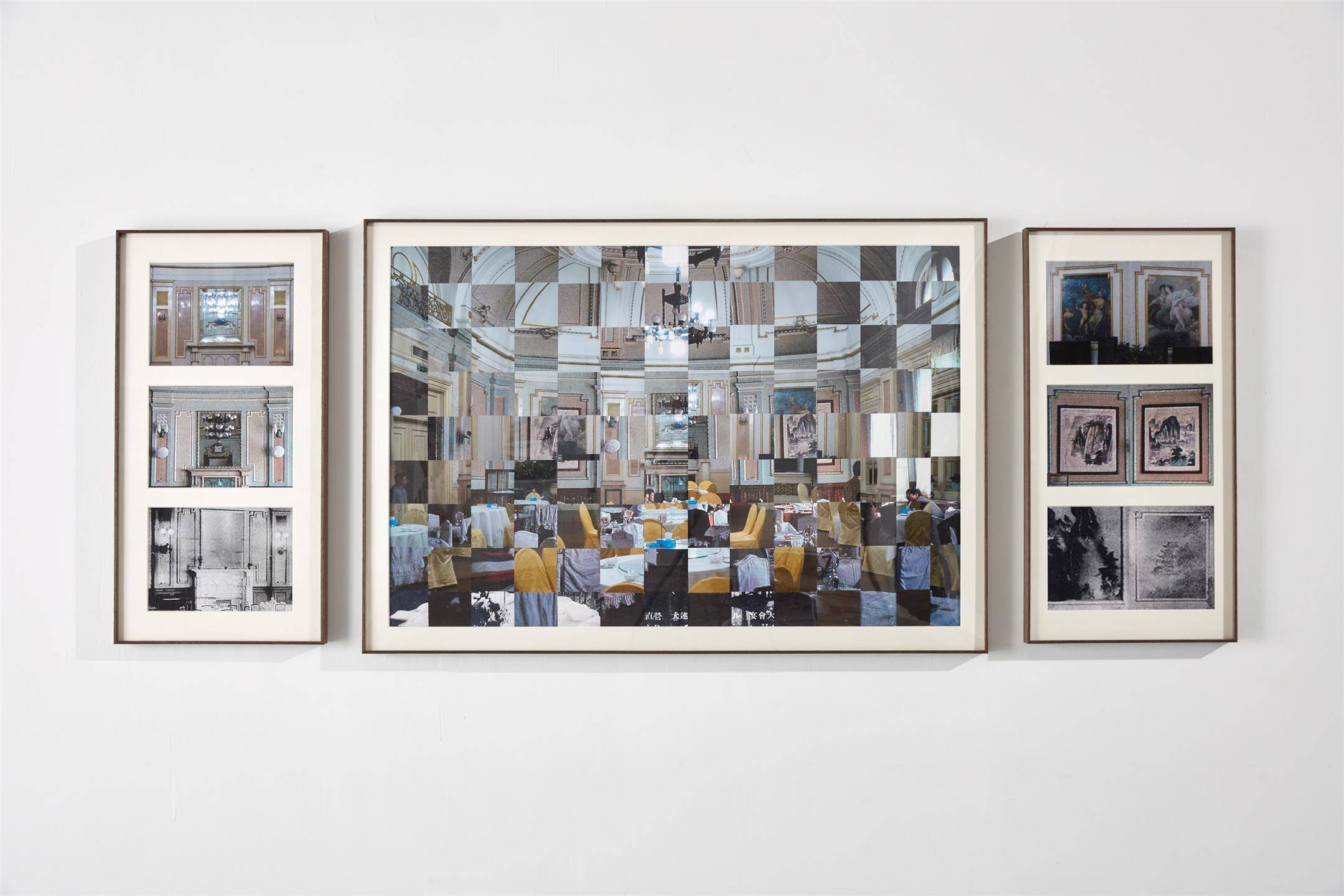
© » KADIST
Guy Woueté
The video installation Le Fou Postcolonial Insane by Guy Woueté is a series of five videos that examine the concept of insanity in the post-colonial Democratic Republic of Congo. The first three videos in the series were shot in a market place in Lubumbashi, the second largest city in the Congo, where several psychoanalysts explore mental health in the context of the Congolese public sphere. Throughout the video series, Woueté links this public health examination to memories of colonial history.

© » KADIST
Nidhal Chamekh
Drawing & Print (Drawing & Print)
Nos visages ( Our Faces ) continues Nidhal Chamekh’s research around visual souvenirs of figures of the past and the light they might shed on our contemporary era. For this series of drawings, the artist draws from articles of French colonial propaganda, specifically the magazine Le Miroir , founded in 1910. In these documents Senegalese and Berber “infantrymen” participating in the First World War were represented in a way that situates them “somewhere between the ethnographical survey and the hackneyed colonial and orientalist image” says Morad Montazami.

© » KADIST
Jesse Chun
O (for various skies) by Jesse Chun is a two-channel video sculpture that decentralizes American colonial narratives about the moon through “unlanguaging”—a methodology that the artist has conceptualized for unfixing language. The project disrupts bureaucratic documents pertaining to the United States government’s lunar colonization and militarization, such as The Lunex Project of 1958 and Project Horizon of 1959, through methods of visual, semiotic, and sonic (mis)translation and abstraction. Chun redacts the found texts, transforming them into concrete poetry, while interweaving lesser known Korean folklore about the moon, such as the precolonial Korean women’s moon dance ( ganggangsullae ) and shamanistic ritual dance for ushering the departed into another world ( gildakeum ).

© » KADIST
Kathy Jetnil-Kijiner
Anointed by Kathy Jetnil-Kijiner and Dan Lin is a poem recital/video that addresses the American nuclear testing legacy in the Marshall Islands that occurred between 1946 to 1958 in Bikini and Enewetak Atolls. The artist’s words of resilience and healing are uttered as she travels across the northeastern atolls of her vast island nation. The climax of the short film takes place when the artist, holding white coral stones (a Marshallese funeral ritual) stands on top of the massive concrete dome erected on Runit Island in Enewetak Atoll to contain 73,000 square meters of radioactive waste—only a small fraction of the debris generated by the nuclear tests, the rest of which was never cleaned up.

© » KADIST
Santiago Yahuarcani
Drawing & Print (Drawing & Print)
The series Castigos del caucho by Santiago Yahuarcani originates in the oral memory transmitted by the artist’s grandfather, who was a survivor of the Putumayo genocide where thousands of Indigenous people were annihilated and enslaved to extract rubber from the Amazon forest between 1879 and 1912. Yahuarcani’s complex narrative paintings on tree bark highlight a long history of colonial violence against the Uitoto and other Indigenous communities. They also show the destruction of the rainforest under Western models of extraction, privatization, and development.

© » KADIST
Mathieu Abonnenc
Secteur IX B is full of ghosts: some that you can see, briefly appearing at the turn of a statue in an under construction museum, some that you only dream of when you switch from day to night, of one space to another. Mathieu Kleyebe Abonnenc invites us to follow a main character, Betty, an ethnographer currently leading research in the archives of the Theodore Monod Museum for African Arts, in Dakar. Punctuated by an anguished soundtrack and borrowing tropes from thriller genre films to create a sense of oddity, the film comments on the contemporary effects of colonial legacy in cultural institutions.

© » KADIST
Bakudapan Food Study Group
Mooi indie (which translates to “Beautiful Indies”) is a term used to depict the beauty of nature in the East Indies during the period of Dutch colonialism in Indonesia. The term is usually used to describe a painting, romanticising the alluring tropics through the lens of European imperialism. Later in the 1950s, the prominent Indonesian painter S. Sudjojono, who is known as one of the founding fathers of Indonesian Modern Art, publicly rejected the Mooi Indie genre as Indonesian art.

© » KADIST
Sammy Baloji
Part-skyscraper, part-pyramid, part-citadel, this unfinished and ragged twelve-story building stands, incongruously, among the industrial environment of Limete. Towering above this desultory landscape and defying gravitational laws and urban zoning rules, this uncommon architectural proposition forms one of the strangest and most enigmatic landmarks of the city. A giant question mark, it begs for profound reflection on the nature of the city, the heritage of its colonial modernist architecture, the dystopian nature of its infrastructure, and the capacity for utopian urban dreams and lines of flight that it nonetheless continues to generate.

© » KADIST
Natalia Lassalle-Morillo
In her film Retiro (2019), Natalia Lassalle-Morillo considers how women pass down memories to their kin as they age. A film within a film, the three-channel portrait combines the scripted film she and her mother made together, behind-the-scenes shots of that film’s production, and interviews with her mother on gendered familial expectations and aging in Puerto Rico. Lassalle-Morillo’s meta approach to story-telling unpacks her relationship to her mother, demonstrating how maternal trauma, history, and myth are made and inherited through disjointed narratives.

© » KADIST
Duane Linklater
silentstar, delicacy by Duane Linklater is a replica of a baby pink hoodie that the artist wore as a teenager, embellished with hand-painted elements and band patches. From associations with punk and hip-hop to skater culture, the hoodie has a history of being adopted by youth-driven communities once relegated to the fringes, and being embraced by mainstream fashion as a practical article of clothing, which Linklater’s work complicates even further. The reproduction is made with dye extracted from cochineal insects.

© » KADIST
Tracey Rose
“Maqe II” is at first glance a romantic image of three diaphanous angels hovering in the luminous sky over a South African township. A closer inspection reveals that the apparition is the appropriated figure of Marie Antoinette from the artist’s Ciao Bella series (2001) with the addition of a butchered cake. The figure is Rose herself dressed in costumed made of trash bags holding a haunting paper mâché mask.

© » KADIST
Nandan Ghiya
The Chair (2012) foregrounds media-based tensions between analog and digital imaging technologies as a means of challenging the continued circulation of visual ephemera from India’s colonial past. A mix of found photographs and staged studio portraits deliberately made to look older, The Chair features multiple portraits of figures dressed in period costumes that reference the ornate fashions popular during Great Britain’s imperial rule of India. A hybrid frame wraps around this assemblage, a composite of variously ornate and simple wood finishes culled from disused and forgotten pictures.

© » KADIST
Bady Dalloul
Drawing & Print (Drawing & Print)
The Great Game is a series of works composed of a number of card combinations illustrated by the faces of key political figures shaping the geopolitical landscape in the Middle East. Each reconstituted ‘hand of play’ corresponds to a diplomatic treaty establishing or modifying geographical borders. The plastic form of a poker hand chosen by the artist highlights the randomness of the process of fixing boundaries and the way in which they do not account for the lives of those located there.
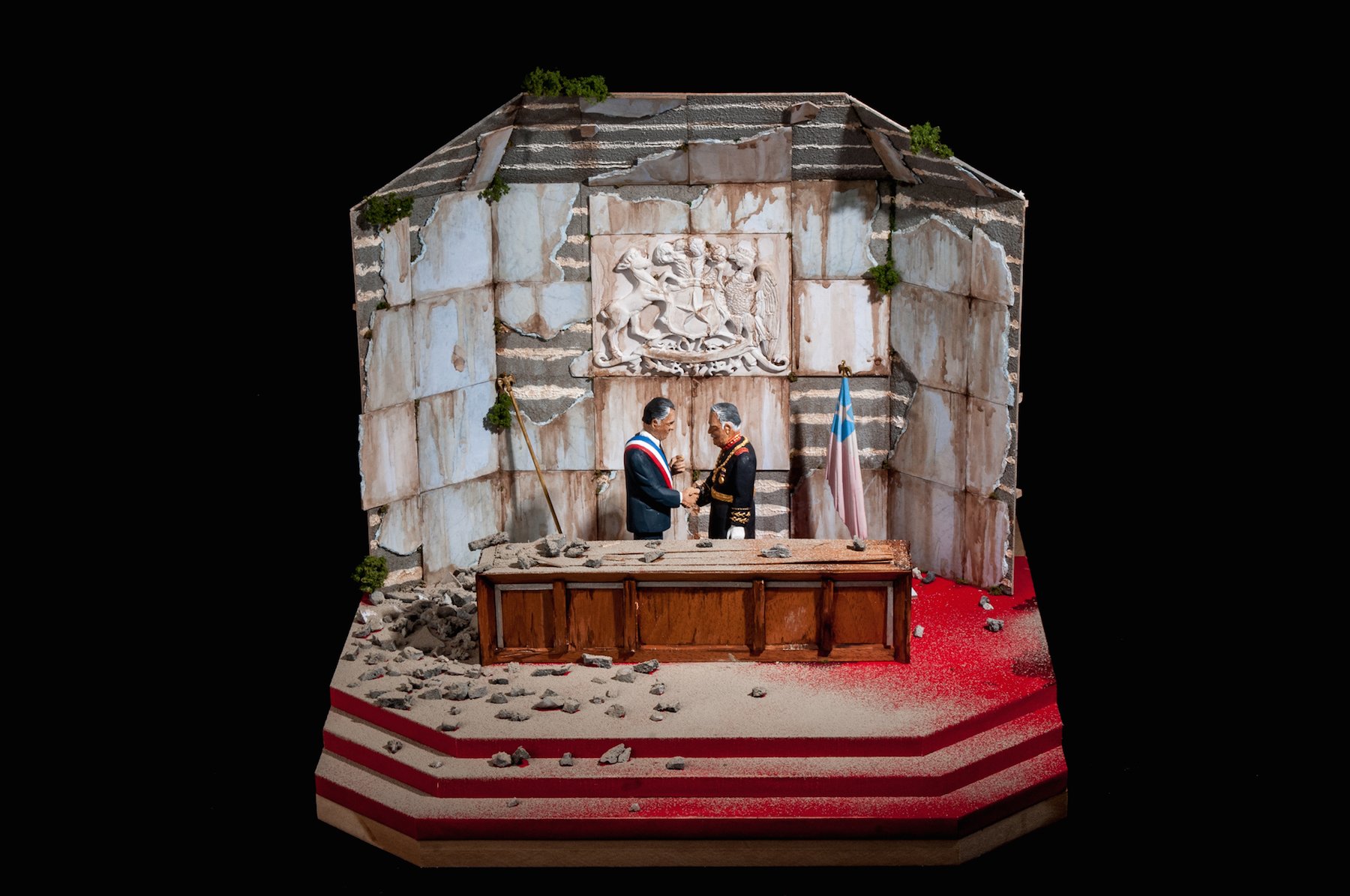
© » KADIST
Nicolás Grum
El gran pacto de Chile (The Great Pact) and La balserita de Puerto Gala (The Raft) were part of the “Museo Futuro”, an exhibition in which the artist presented nine miniature dioramas staging fragments of Chile’s history, from its colonial invasions to the present. Through the episodes he chose to depict, the artist focused on historical narratives, the way the story is told, and the supposed irrefutability of historical facts. Museo Futuro (“Future Museum”) stands within a tradition of artists who re-read history and offer their interpretation of it through the distopic lens of the museum display.

© » KADIST
Corey McCorkle
Corey McCorkle’s 2016 installation Pendulum is developed around the Cavendish family and their role in importing bananas to Europe. Cavendish bananas were named after William Cavendish, the 6th Duke of Devonshire. In 1834, Cavendish received a shipment of bananas from Mauritius, and developed these bananas in the greenhouses of Chatsworth House with his gardener Sir Joseph Paxton, and were later given to missionary John Williams to take to Samoa.

© » KADIST
Thu Van Tran
From Green to Orange is a series of silver films immersed in a bath of dye and rust. While the perception of the subject is made difficult by the chemical reaction, vegetation becomes discernible at a closer look. Thu Van Tran interferes in the depths of a mystery, in the density of a hallucinated dream.

© » KADIST
Ana Vaz
Ana Vaz describes her film É Noite na América (It is Night in America) as an eco-terror tale, freely inspired by A cosmopolitics of animals by Brazilian philosopher Juliana Fausto; in which she investigates the political life of non-human beings and questions the modern idea of the exceptionality of the human species. In parallel to the feature film version, Vaz created a three-channel installation format meant to be displayed in contemporary art spaces. This edition includes three complementary video works that expand on the conceptual frameworks of the film.

© » KADIST
Jota Mombaça
The performance title A Gente Combinamos De Não Morrer (BANDEIRA #1) / Us Agreed Not To Die (FLAG #1) is taken from a short story by Brazilian writer Conceição Evaristo, whose work addresses violence, resilience, and necropolitics with an Afro-diasporic lens. This artwork by Jota Mombaça articulates connections between black and trans people’s challenges and struggles. Mombaça points out that an ongoing genocide of these minorities underscores the established power structures, and their resistance is to survive.
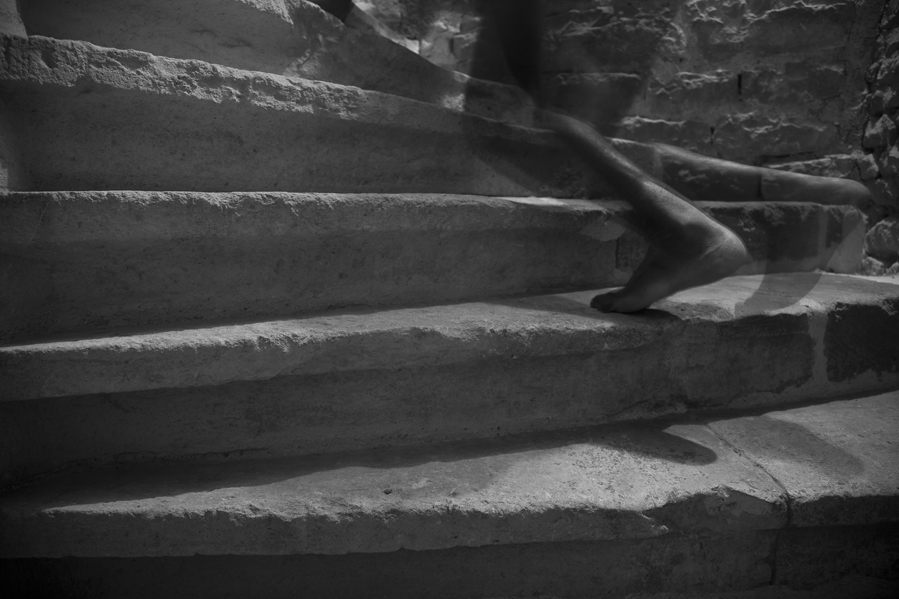
© » KADIST
Em'kal Eyongakpa
Em’kal Eyongakpa was born in Cameroon in 1981. After obtaining a postgraduate diploma in Botany and Ecology, he decided to concentrate exclusively on visual and sound art. His use of poetic, symbolic and surrealistic imagery is often sprinkled with paradoxes that challenge the obvious.

© » KADIST
Sofía Córdova
dawn chorus ii: el niagara en bicicleta is a work produced in Sofía Córdova native Puerto Rico and was largely shaped by the financial crisis, the islands’ histories under colonial rule and most recently, the climate-change related natural disasters which have affected the island. The latest of which, hurricane Maria, and the subsequent political mishandling of the situation, gave the project its ending. Prior to the hurricane, this work also engaged in conversation with blackness and anti-blackness in the Caribbean, syncretic religion and dance music as modes of survival and liberation, and fantasy and science-fictional strategies as means to break out of our current arc of history.

© » KADIST
Gary-Ross Pastrana
Gary-Ross Pastrana’s video installation Rewilding consists of three large-scale projections placed across the exhibition space. The poetic footage filmed by the artist portrays three interconnected worlds: a colony of termites; a piano repair workshop in the outskirts of Manila; and an empty concert theatre. Their interconnectivity is shaped by the voice-over of three narrators: a musician discussing the balance between order and chaos found in classical music; a piano repairman describing termite infestations in an instrument of European origin; and a scientist describing the unique social structures of this tropical parasite.

© » KADIST
Daniel Boyd
Daniel Boyd’s work WTEIA3 is part of a series of paintings that reference the stick charts used by indigenous communities on the Marshall Islands. These charts were made in order to navigate the Pacific ocean by canoe and thus crucially depict ocean swell patterns. These highly individualised maps were rarely intended for mass use but instead for memorising, and transmitting between the community, the maps were not taken to sea but instead memorised in advance.

© » KADIST
Hong-Kai Wang
The video Music While We Work (2011) is the first part/work of a long-term research project started in 2010. The project revolves around and beyond the history of sugar in the small town Huwei in central Taiwan (the artist’s hometown). The town was nicknamed as the “Capital of Sugar” during the Japanese colonial ruling (1895-1945) of Taiwan.

© » KADIST
Caroline Déodat
Landslides is a cinematographic essay/poem by Caroline Déodat in which fictional images are the result of research into the memories of a Mauritian dance born during colonial slavery, the Sega. In the film, the contemporary Mauritian dancer Jean-Renat Anamah crosses mythical landscapes of the Sega that merge with intimate territories. From the pixels of the digital image and the signals of electronic music, this film exhumes in layers of landscapes the spectres of a ritual erased by history through a personal genealogy: between haunting memory and deferred archive.

© » KADIST
Christian Nyampeta
The film Sometimes It Was Beautiful by Christian Nyampeta poetically addresses the systemic conditions leading and emerging from the 1994 Rwandan genocide, which had lasting and profound effects on Rwanda and neighbouring countries like Congo. The divergent opinions of the characters, as well as suggestive gestures, settings, and marks inscribed in the landscape highlight the different approaches in addressing the slow violence linked to the enduring impact of colonialism and imperialism, the pursuit of knowledge, and the conservation of heritage, culture, and object repatriation. Structured into six chapters, the film imagines a meeting between improbable friends and interlaces dialogues, with choreography of dancers, places and objects.

© » KADIST
Carla Zaccagnini
De sino à sina (From Bell to Fate) is a six-channel sound installation by Carla Zaccagnini exploring the relationship between modern Brazil and its colonial past. The sound installation is made from a recording of the bell at Capela de Nossa Senhora do Rosário dos Homens Brancos, a Baroque-style chapel that is one of the first chapels in Ouro Preto (previously Vila Rica) in the region of Minas Gerais. The work references the execution of José da Silva Xavier (1746-1792), also known as “Tiradentes”.
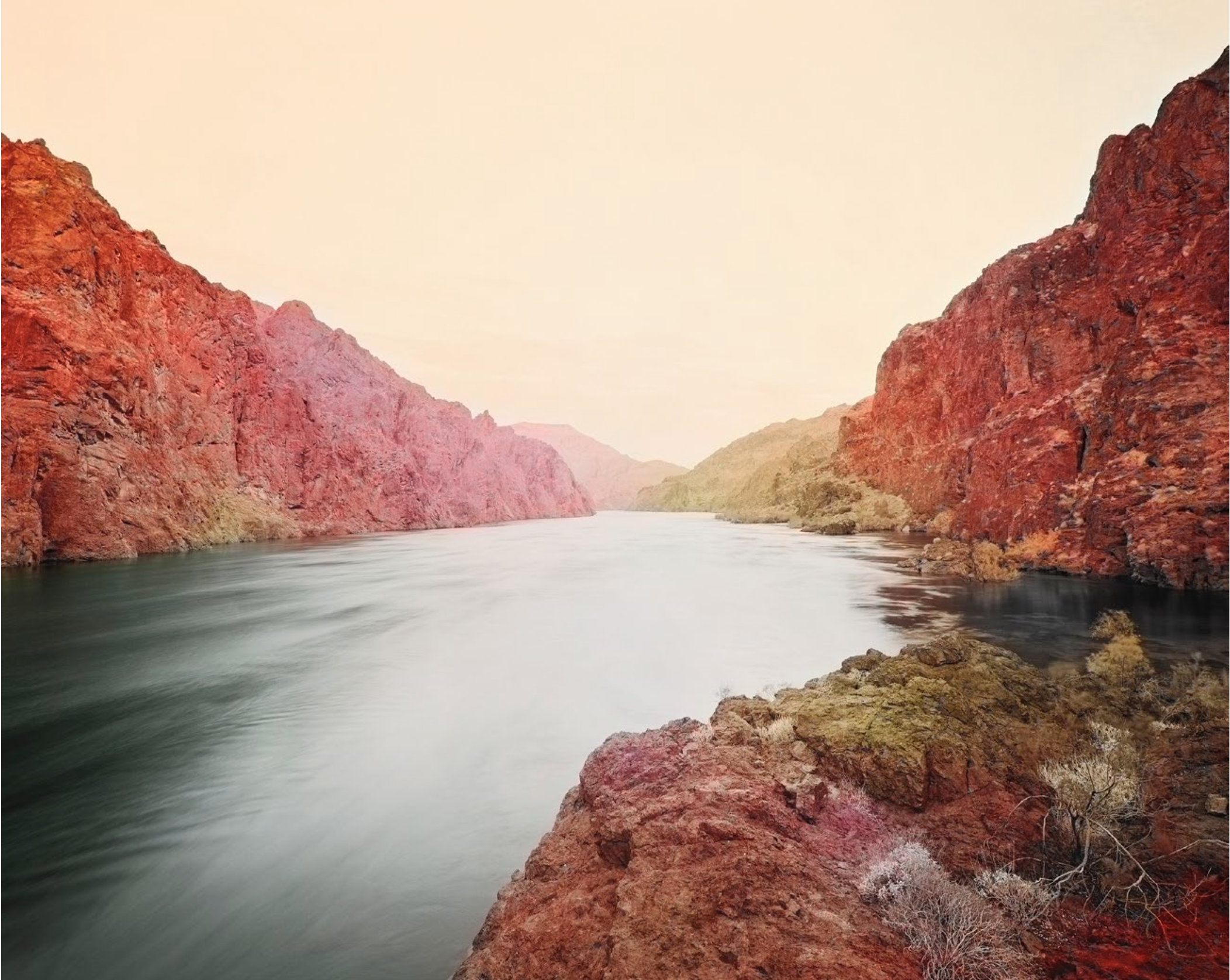
© » KADIST
Trevor Paglen
The Black Canyon Deep Semantic Image Segments by Trevor Paglen merges traditional American landscape photography (sometimes referred as ‘frontier photography’ for sites located in the American West) with artificial intelligence and other technological advances such as computer vision. In order to take this photograph, Paglen traveled to the Black Canyon, south of the Hoover Dam. Only accessible by water, Paglen piloted a boat up the Colorado river into the canyon.

© » KADIST
Michael Rakowitz
The Ballad of Special Ops Cody by Michael Rakowitz is a serio-comic stop motion animated film in which an everyday African-American G. I. character, personified through an action figure that comes to life. The protagonist breaks into Chicago’s Oriental Institute to “liberate” Mesopotamian votive statues, who are likewise animated through voice-over narration, from their imprisonment in the museum’s vitrines. This set-up allows for meditations on various war and colonial histories; as a barbed twist on the Bush-era rhetoric of promoting “democracy” in the Middle East through regime change, the G. I. cannot understand why the statues wish to remain in the museum and not return to their (currently war torn) “homelands”.

© » KADIST
Trevor Paglen
Half Dome Hough Transform by Trevor Paglen merges traditional American landscape photography (sometimes referred as ‘frontier photography’ for sites located in the American West) with artificial intelligence and other technological advances such as computer vision. This photograph was taken at Half Dome, a frequently visited granite rock formation in Yosemite National Park, California. For this work, Paglen created a digital file of the 8 x 10 inch photographic negative so that the artificial intelligence program can apply computer vision to evaluate the content of the image.

© » KADIST
Shahzia Sikander
The Last Post was inspired by Sikander’s ongoing interest in the colonial history of the sub-continent and the British opium trade with China. In this animation, layers of images, abstract forms, meaning, and metaphorical associations slowly unfold at the same time that more visual myths are created. The identity of the protagonist, a red-coated official, is indeterminate and suggestive of both the mercantilist policies that led to the Opium Wars with China and the cultural authority claimed by the Company school of painting over colonial India.
Abraham Oghobase
Abraham Onoriode Oghobase’s artistic practice explores identity in relation to socio-economic and historic geographies...
Trevor Paglen
Trevor Paglen’s work combines the knowledge-base of artist, geographer and activist...
Sancintya Mohini Simpson
Sancintya Mohini Simpson is an artist, writer, and researcher whose work addresses the impact of colonization on the historical and lived experiences of her family and broader diasporic communities...
Ana Vaz
Ana Vaz is an artist and filmmaker whose works speculate on the relationships between self and other, and myth and history, through a cosmology of signs, references, and perspectives...
Daniela Ortiz
In order to reveal and critique hegemonic structures of power, Daniela Ortiz constructs visual narratives that examine concepts such as nationality, racialization, and social class...
Vvzela Kook
Vvzela Kook works in multiple media, including AV, performance, theatre, computer graphics, 3D printing, and drawing, often combining recent technology with artistic imagination and skill to navigate and describe cityscapes, their memory, connections, and hidden cybernetic structures, playing both with human sensorial perception and narrative devices...
Dale Harding
A descendant of the Bidjara, Ghungalu, and Garingbal peoples, Dale Harding’s work references and expands upon the philosophical and spiritual touchstones of his cultural inheritance...
Richard Bell
Richard Bell works across a variety of media including painting, installation, performance and video and text to pose provocative, complex, and humorous challenges to our preconceived ideas of Aboriginal art, as well as addressing contemporary debates around identity, place, and politics...
Yuyan Wang
Yuyan Wang is a filmmaker and multidisciplinary artist whose work examines images at the point of production and the atmosphere cultivated by media regimes within the attention economy...
Ximena Garrido Lecca
- location: London, United Kingdom
- year born: 1980
- gender: female
- nationality: Peruvian
- home town: Lima, Peru
Rometti Costales
Rometti Costales is an artistic collaboration between Julia Rometti and Victor Costales that began in 2007...
Corey McCorkle
Described as a ‘spatial interventionist’, Corey McCorkle is a New York-based artist and trained architect, working in photography, architectural interventions, sculpture, installations, and films...
Kent Chan
As an artist, curator, and filmmaker; Kent Chan’s practice revolves around encounters with art, fiction, and cinema that form a trio of practices porous in form, content, and context...
Thu Van Tran
Thu Van Tran grew up in the paradox of the dismantlement of the French colonial empire in Vietnam...
Matthew Angelo Harrison
Detroit’s Matthew Angelo Harrison works at the intersection of sculpture and technology, building his own 3D printers (which rise to the status of sculpture), and using these creations to formulate others...
Em'kal Eyongakpa
Em’kal Eyongakpa was born in Cameroon in 1981...
Felipe Arturo
- year born: 1979
- gender: male
- nationality: Colombian
- home town: Bogota, Colombia
Fabien Giraud & Raphael Siboni
The collaborative work of Fabien Giraud and Raphael Siboni is part of a reflection on the history of cinema, science, and technology...
Naresh Kumar
Naresh Kumar (b...
Nandan Ghiya
Nandan Ghiya is an emerging whose practice explores the disjunction between various forms of image-based media...
Juan Brenner
Born and raised in Guatemala, photographer Juan Brenner spent ten years in New York City working in the fashion industry before returning to his home country in 2008...
Nadia Myre
The work of Nadia Myre, member of the Kitigan Zibi Anishinabeg First Nation, is notable for its embrace of cross-cultural mediations as a strategy towards celebrating and reclaiming the far-reaching intellectual and aesthetic contributions of Indigenous communities...
Nalini Malani
- year born: 1946
- gender: female
- nationality: Indian
- home town: Karachi, Pakistan
Shubigi Rao
Shubigi Rao interrogates how we know what we do and how we remember what we do...
Khvay Samnang
Khvay Samnang’s work critically examines the interlocking nature of ritual and politics, the humanitarian and ecological impacts of globalization, colonialism and migration, and the cultural-material histories of exchange that have shaped the Southeast Asia region...
Papa Ibra Tall
A crucial figure in the history of African modernism, Papa Ibra Tall was a renowned tapestry weaver, painter, and illustrator...
Yee I-Lann
- location: Kuala Lumpur, Malaysia
- year born: 1971
- gender: female
- nationality: Malaysian
- home town: Sabah, Malaysia
Jane Jin Kaisen and Guston Sondin-Kung
Working with narrative experimental film, multi-channel video installation, performative video art, photography, and text, Jane Jin Kaisen engages themes of memory, trauma, migration and translation at the intersection of personal and collective histories...
Hong-Kai Wang
Wang is an artist working primarily with sound...
Ali Cherri
The work of Ali Cherri, currently based in Beirut and in Paris, travers the traces of war in Lebanon in the landscape and in the collective memory...
-
1970-1979
Aubrey Williams
1972Carib Carnival illustrates Aubrey Willams’s unique artistic language, combining Pre-Columbian iconography with abstraction...
Antonio Ole
1978Antonio Ole’s Rhythm of N’gola Rhythms (1978), is a film about the struggle for Angolan political independence...
-
2000-2009
Tracey Rose
2001“Maqe II” is at first glance a romantic image of three diaphanous angels hovering in the luminous sky over a South African township...
Ahmad Fuad Osman
2007Recollections of Long Lost Memories by Ahmad Fuad Osman is a series of 71 black and white sepia-toned archival photographs that chart, with nostalgia, the social encounters between hierarchies of life in the Malay world...
Joscelyn Gardner
Drawing & Print
2009(Drawing & Print) Creole Portraits III alludes to the 18th century practice by slave women on Caribbean plantations of using tropical plants as natural abortifacients...
Fred Wilson
2009Fred Wilson’s flag paintings document the 20th century history of African people, indexing the period of liberation from colonialism...
-
2010-2019
Shahzia Sikander
2010The Last Post was inspired by Sikander’s ongoing interest in the colonial history of the sub-continent and the British opium trade with China...
Jane Jin Kaisen and Guston Sondin-Kung
2010The Woman, The Orphan, and The Tiger begins with the sound of women’s voices describing histories of violence, of things repressed and silenced...
Hong-Kai Wang
2011The video Music While We Work (2011) is the first part/work of a long-term research project started in 2010...
Kiluanji Kia Henda
2011Redefining The Power (with Didi Fernandes) is a metaphor of how reflections on history and society during the Angolan Civil War (1975-2002) are largely ignored within the canon of history...
Engel Leonardo
2011As with so many other colonized geographies, the ways in which violence has become a natural and expected component of Santo Domingo reflects the forced friendship between the beneficiaries and residues of Modernism...
Nandan Ghiya
2012The Chair (2012) foregrounds media-based tensions between analog and digital imaging technologies as a means of challenging the continued circulation of visual ephemera from India’s colonial past...
Nalini Malani
2012Malani draws upon her personal experience of the violent legacy of colonialism and de-colonization in India in this personal narrative that was shown as a colossal six channel video installation at dOCUMENTA (13), but is here adapted to single channel...
Leah Gordon
2012The Caste Portraits Series by Leah Gordon investigates the practice of grading skin color from black to white, which marked the extent of racial mixing in 18th century Haiti...
Ícaro Lira
2012Icaro Lira has been developing the project “Museum of the Foreigner” since 2015, in which he recounts the trajectories of populations inside Brazil, from the north to the big cities of the south...
Felipe Arturo
2012Defined as entropy, the second law of thermodynamics proposes that energy is more easily dispersed than it is concentrated...
Tom Nicholson
2012Tom Nicholson’s Comparative Monument (Palestine) engages a peculiar Australian monumental tradition: war monuments that bear the name “Palestine”...
Beatriz Santiago Muñoz
2013Another curious element is that it seemed that I was seeing images from the dreams I had that afternoon...
Rometti Costales
2013This anarchist flag is made from Huayruro seeds, a native plant of South and Central American tropical areas...
Daniela Ortiz
2013Previously, Ortiz produced a series of photographs related to her research on the position of ‘service architecture’, the vital space given to domestic servants in the modernist architectural houses of South American upper class families...
Yee I-Lann
2013Sarcastically titled to call attention to the problematic notions underlying colonialism, this photograph shows hundreds of Native Malaysians seated quietly behind one of their colonial oppressors...
Nicolás Grum
2014El gran pacto de Chile (The Great Pact) and La balserita de Puerto Gala (The Raft) were part of the “Museo Futuro”, an exhibition in which the artist presented nine miniature dioramas staging fragments of Chile’s history, from its colonial invasions to the present...
Thu Van Tran
2014From Green to Orange is a series of silver films immersed in a bath of dye and rust...
Ximena Garrido Lecca
2014Destilaciones ( Distillations , 2014) is an installation composed of a group of ceramic pots, presented on the floor and within a steel structure...
Nicolás Grum
2014El gran pacto de Chile (The Great Pact) and La balserita de Puerto Gala (The Raft) were part of the “Museo Futuro”, an exhibition in which the artist presented nine miniature dioramas staging fragments of Chile’s history, from its colonial invasions to the present...
Hank Willis Thomas
2014South Africa Righteous Space by Hank Willis Thomas is concerned with history and identity, with the way race and ‘blackness’ has not only been informed but deliberately shaped and constructed by various forces – first through colonialism and slavery, and more recently through mass media and advertising – and reminds us of the financial and economic stakes that have always been involved in representations of race....
Khvay Samnang
2014The video Rubber Man continues exploring issues related to land use, also noticeable in his Untitled series (2011)...
Mathieu Abonnenc
2015Secteur IX B is full of ghosts: some that you can see, briefly appearing at the turn of a statue in an under construction museum, some that you only dream of when you switch from day to night, of one space to another...
Matthew Angelo Harrison
2015In Hole #1 a zebra scull stands in as a representation of Africa, while the plexiglass box and the hole made through it represent the inaccessibility of that culture to African-Americans....
Beatriz Santiago Muñoz
2015Marché Salomon by Beatriz Santiago Muñoz depicts two meat vendors, a young man and woman, chatting in Marché Salomon, a busy Port-au-Prince market...
Newell Harry
2015(Untitled) Nimoa and Me: Kiriwina Notations by Newell Harry brings together a litany of contemporary politics—mobilization around enduring racism, the legacies of Indigenous and independence struggle, and the prospects of global solidarity against neocolonialism and social injustice...
Naresh Kumar
Drawing & Print
2015(Drawing & Print) “Relation between Black and blood” explores the connection between performance, installation and representation...
Gaëlle Choisne
2015Entre Chien et Loup is an installation incorporating a variety of media: rubber, discs, feathers and confetti that the artist weaves, sews and glues together...
Naufus Ramírez-Figueroa
2015Naufus Ramírez-Figueroa’s performance Illusion of Matter establishes a dream state through a composition of motifs that were drawn from the artist’s childhood memories...
Carolina Caycedo
2015Carolina Caycedo’s practice conveys her very personal passion and relationship to water, as a powerful necessity and spiritual reminder...
Corey McCorkle
2016Corey McCorkle’s 2016 installation Pendulum is developed around the Cavendish family and their role in importing bananas to Europe...
Nohemí Pérez
Drawing & Print
2016(Drawing & Print) A rich and isolated region, El Catatumbo is located near the border with Venezuela...
Isadora Neves Marques
2016The Pudic Relation between Machine and Plant shows a looped scene where a robotic hand touches a “sensitive plant” — Mimosa Pudica, a species characteristic for closing on itself when touched...
Santiago Yahuarcani
Drawing & Print
2017(Drawing & Print) The series Castigos del caucho by Santiago Yahuarcani originates in the oral memory transmitted by the artist’s grandfather, who was a survivor of the Putumayo genocide where thousands of Indigenous people were annihilated and enslaved to extract rubber from the Amazon forest between 1879 and 1912...
Bady Dalloul
Drawing & Print
2017(Drawing & Print) The Great Game is a series of works composed of a number of card combinations illustrated by the faces of key political figures shaping the geopolitical landscape in the Middle East...
Daniel Boyd
2017Daniel Boyd’s work WTEIA3 is part of a series of paintings that reference the stick charts used by indigenous communities on the Marshall Islands...
Michael Rakowitz
2017The Ballad of Special Ops Cody by Michael Rakowitz is a serio-comic stop motion animated film in which an everyday African-American G...
Jorge González
2017Easy to fold and carry, Jorge González’s Banquetas Chéveres (Chéveres Stools) embody the nomadic and flexible nature of the Escuela de Oficios...
Ali Cherri
2017As a discipline born at the same time as colonialism, archeology is struggling to rid itself of this sad context...
Antonio Pichillá
2017Wind by Antonio Pichillá is a textile piece depicting the glyph that represents the element wind in the Mayan tradition...
Danielle Dean
2017In True Red Ruin (Elmina Castle) , Danielle Dean uses archival documents to re-imagine colonial history from the 1400s, while also referencing her own personal history...
Sky Hopinka
2017Dislocation Blues by Sky Hopinka is a portrait of the 2016 Standing Rock protests against the Dakota Access Pipeline in South Dakota...
Christian Nyampeta
2018The film Sometimes It Was Beautiful by Christian Nyampeta poetically addresses the systemic conditions leading and emerging from the 1994 Rwandan genocide, which had lasting and profound effects on Rwanda and neighbouring countries like Congo...
Jota Mombaça
2018The performance title A Gente Combinamos De Não Morrer (BANDEIRA #1) / Us Agreed Not To Die (FLAG #1) is taken from a short story by Brazilian writer Conceição Evaristo, whose work addresses violence, resilience, and necropolitics with an Afro-diasporic lens...
Carla Zaccagnini
2018De sino à sina (From Bell to Fate) is a six-channel sound installation by Carla Zaccagnini exploring the relationship between modern Brazil and its colonial past...
Kathy Jetnil-Kijiner
2018Anointed by Kathy Jetnil-Kijiner and Dan Lin is a poem recital/video that addresses the American nuclear testing legacy in the Marshall Islands that occurred between 1946 to 1958 in Bikini and Enewetak Atolls...
Sofía Córdova
2018dawn chorus ii: el niagara en bicicleta is a work produced in Sofía Córdova native Puerto Rico and was largely shaped by the financial crisis, the islands’ histories under colonial rule and most recently, the climate-change related natural disasters which have affected the island...
Bakudapan Food Study Group
2018Mooi indie (which translates to “Beautiful Indies”) is a term used to depict the beauty of nature in the East Indies during the period of Dutch colonialism in Indonesia...
Gary-Ross Pastrana
2018Gary-Ross Pastrana’s video installation Rewilding consists of three large-scale projections placed across the exhibition space...
Frida Orupabo
2018The archival images used by Frida Orupabo in her collages trace stereotyped representations of race, gender, sexuality and violence...
Abraham Oghobase
2018This series of photographs is inspired by the artist’s travels to Jos, Nigeria...
Bayrol Jiménez
2018Sombras de los Valles (Shadows of the Valleys) is part of a series of works created by Bayrol Jiménez in which he is influenced by hand-painted signs and large billboards in Mexico...
Fabien Giraud & Raphael Siboni
2018– In which an intelligence going back to its place of origin discovers the agony of gods on which it thrives – Seventh and last episode of The Unmanned , “a flood” is set in 1542 as the first conquistadors enter the land later to be known as the Silicon Valley...
Cian Dayrit
2018Yuta Nagi Panaad (Promised Land) by Cian Dayrit addresses the impacts of the globalized economy and its powerful ideology on the spaces of everyday life...
Abraham Oghobase
2018This series of photographs is inspired by the artist’s travels to Jos, Nigeria...
Juan Brenner
2018The photographic series Tonatiuh (The Son of the Sun) by Juan Brenner is an in-depth visual study of current Guatemalan society from the perspective of miscegenation and the incalculable consequences of the Spanish conquest...
Dale Harding
2018Dale Harding’s installation Body of Objects consists of eleven sculptural works that the artist based on imagery found at sandstone sites across Carnarvon Gorge in Central Queensland...
Nadia Myre
2018First exhibited as part of the recent multidisciplinary project Code Switching and Other Work , at Art Mûr, Berlin in late 2018, Nadia Myre’s Untitled (Tobacco Barrel) takes inspiration from the cylindrical vessels used to import tobacco from North America to Europe during periods of early colonial settlement...
Abraham Oghobase
2018This series of photographs is inspired by the artist’s travels to Jos, Nigeria...
Abraham Oghobase
2018This series of photographs is inspired by the artist’s travels to Jos, Nigeria...
Karrabing Film Collective
2018The Mermaids, or Aiden in Wonderland by Karrabing Film Collective is a surreal exploration of Western toxic contamination, capitalism, and human and non-human life...
Natalia Lassalle-Morillo
2019In her film Retiro (2019), Natalia Lassalle-Morillo considers how women pass down memories to their kin as they age...
Guy Woueté
2019The video installation Le Fou Postcolonial Insane by Guy Woueté is a series of five videos that examine the concept of insanity in the post-colonial Democratic Republic of Congo...
Nidhal Chamekh
Drawing & Print
2019(Drawing & Print) Nos visages ( Our Faces ) continues Nidhal Chamekh’s research around visual souvenirs of figures of the past and the light they might shed on our contemporary era...
Noé Martínez
2019As he investigates the forms that slavery took through different events that occurred during the sixteenth century in the Huasteca region of Mexico, Noé Martínez tells, in a non-linear narrative, the history of human trafficking in Relación de tráfico de personas 1525-1533 I (Study of Trafficking of Persons 1525–1533 I) ...
Musquiqui Chihying and Gregor Kasper
2019Addressing the legacy of colonialism, The Guestbook by Musquiqui Chihying and Gregor Kasper is a slow-paced, black-and-white film exploring the German colony of Togoland, now the Republic of Togo...
Noara Quintana
2019The series Belle Époque of the Tropics by Noara Quintana has as its background the history of the rubber industrialization in North of Brazil...
Shubigi Rao
2019Named after a book that artist Shubigi Rao read growing up, The Yellow Scarf explores the history of the Thuggee cult in India in relation to the colonial British administration that ‘discovered’ but also ultimately exterminated this cult of assassins...
Vvzela Kook
2019Columbus of Horticulture stems from Vvzela Kook’s ongoing research into the central and often-ignored role that botany played in the history of European imperialism...
Sancintya Mohini Simpson
Drawing & Print
2019(Drawing & Print) And words were whispered by Sancintya Mohini Simpson is a series of ten works on paper based on the lived experiences of Indian women taken to the Natal region of South Africa from the 1860s to the early 1900s to work in tea and sugarcane plantations during apartheid, which included servitude in its broadest and most sinister definition...
Karla Dickens
2019Karla Dickens’s collage Beneath the skim board addresses issues of discrimination and racism towards Indigenous communities in Australia through a constellation of historical and current events...
Luka Yuanyuan Yang
2019Composed of three photographic panels, Three Times at Yamato Hotel by Luka Yuanyuan Yang is a part of the artist’s ongoing project Dalian Mirage , a seven act play in a theatre staged as the city of Dalian...
Claudia Martínez Garay
2019escenario chacana by Claudia Martínez Garay is a sculptural work composed of a frame-like structure that contains a series of ceramic pieces...
Musquiqui Chihying
2019The Sculpture by Musquiqui Chihying comprises a two-channel lecture performance and a photograph...
-
2020-2029
Duane Linklater
2020silentstar, delicacy by Duane Linklater is a replica of a baby pink hoodie that the artist wore as a teenager, embellished with hand-painted elements and band patches...
Trevor Paglen
2020Half Dome Hough Transform by Trevor Paglen merges traditional American landscape photography (sometimes referred as ‘frontier photography’ for sites located in the American West) with artificial intelligence and other technological advances such as computer vision...
Trevor Paglen
2020The Black Canyon Deep Semantic Image Segments by Trevor Paglen merges traditional American landscape photography (sometimes referred as ‘frontier photography’ for sites located in the American West) with artificial intelligence and other technological advances such as computer vision...
Caroline Déodat
2020Landslides is a cinematographic essay/poem by Caroline Déodat in which fictional images are the result of research into the memories of a Mauritian dance born during colonial slavery, the Sega...
Runo Lagomarsino
2020Yo también soy humo (I am also smoke) is a 16mm film that has been digitized to video...
Jesse Chun
2021O (for various skies) by Jesse Chun is a two-channel video sculpture that decentralizes American colonial narratives about the moon through “unlanguaging”—a methodology that the artist has conceptualized for unfixing language...
Sancintya Mohini Simpson
2021Dhuwã (term used by indentured people of Natal for ‘smoke’), is a single-channel film by Sancintya Mohini Simpson that traces back to the lived experiences of indentured labourers taken from India to Natal (now KwaZulu-Natal, South Africa) to work on sugar plantations during the late 1800s and early 1900s...
Nikau Hindin
2021Maori barkcloth making is the central artistic form in the Pacific, and still at the core of cultural expression in many Pacific countries...
Pangrok Sulap
Drawing & Print
2021(Drawing & Print) All Nations are Created Special is a black and white woodcut print by the artist collective Pangrok Sulap...
Kent Chan
2021Heat Waves by Kent Chan examines the contexts, politics, and proliferation of the different aesthetics of heat by drawing from the aesthetics of regions defined by hot and humid climates and associated with histories of coloniality such as ‘the global south’ and the ‘developing world’...
Daniela Ortiz
2021The Rebellion of Roots by Daniela Ortiz depicts a series of situations in which tropical plants, held hostage in the botanical gardens and greenhouses of Europe, are protected and nurtured by the spirits of racialized people who died as a result of European racism...
Ana Vaz
2022Ana Vaz describes her film É Noite na América (It is Night in America) as an eco-terror tale, freely inspired by A cosmopolitics of animals by Brazilian philosopher Juliana Fausto; in which she investigates the political life of non-human beings and questions the modern idea of the exceptionality of the human species...
Jota Mombaça
2022Ghost 1: Drowning is not a poem but is not not a poem either by Jota Mombaça is part of a series of sculptures exploring water’s restless, elemental properties and what the artist describes as “the radicality of sinking”...
Michelle and Noel Keserwany
2022Les Chenilles by Michelle and Noël Keserwany is a sensual film that translates the source of women’s oppression into the means for their liberation...
Yuyan Wang
2022The Moon Also Rises by Yuyan Wang comprises a one-channel video and light installation...
Richard Bell
2022For Richard Bell, art is not simply a vehicle through which to represent and convey political content...
Sandra Monterroso
Drawing & Print
2023(Drawing & Print) Presented as part of a recent group of works titled The Paradox of Healing, Rhombus for Healing No...









